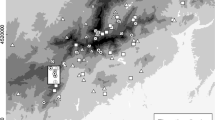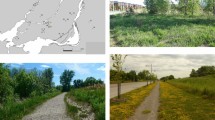Abstract
The distribution of the narrowly endemic butterfly Pseudophilotes sinaicus (Lycaenidae) was studied. Potential habitat within its range was first located and then the quality of that habitat assessed. Degree of shelter, diversity of plant species, and resource area of an individual food plant (Thymus decussatus) all affected habitat quality and together were used to develop an index of habitat suitability applicable to each site. The butterfly's distribution was then studied within the identified network of suitable habitat patches: isolated patches with a small resource area were least likely to contain butterflies. Population size in a patch (as opposed merely to patch occupancy) was affected by resource area and the quality of habitat within that patch. Metapopulation processes and variation in habitat quality therefore appear to combine to describe the distribution of patches occupied by P. sinaicus and their population sizes. This finding provides insights into some of the processes operating on an endemic species throughout its geographical range and has important implications for the conservation of this rare butterfly.




Similar content being viewed by others
References
Åberg J, Jansson G, Swenson JE, Angelstam P (1995) The effect of matrix on the occurrence of hazel grouse (Bonasa bonasa) in isolated habitat fragments. Oecologia 103:265–269
Arnold RA (1983) Ecological studies of six endangered butterflies (Lepidoptera, Lycaenidae): island biogeography, patch dynamics and the design of habitat preserves. Entomology, vol 99. University of California, Calif.
Baguette M, Petit S, Queva F (2000) Population structure and migration of three butterfly species within the same habitat network consequences for conservation. J Appl Ecol 37(1):100–108
Beuret H (1958) Zur Systematischen Stellung einiger wenig bekannter Glaucopsychidi. Mitt Entomol Ges Basel NF 8(6):81–100
Brown JH, Stevens GC, Kaufman DM (1996) The geographic range: size, shape, boundaries, and internal structure. Annu Rev Ecol Syst 27:597–623
Dennis RL, Eales HT (1997) Patch occupancy in Coenonympha tullia: habitat quality matters as much as patch size and isolation. J Insect Conserv 1(3):167–176
Dennis RL, Eales HT (1999) Probability of site occupancy in the large heath butterfly Coenonympha tullia, determined from geographical and ecological data. Biol Conserv 87(3):295–301
Gall LF (1984) Population structure and recommendations for conservation of the narrowly endemic alpine butterfly, Boloria acrocnema (Lepidoptera:Nymphalidae). Biol Conserv 28:111–138
Gilpin ME, Hanski I (eds) (1991) Metapopulation dynamics: empirical and theoretical investigations. Academic Press, London
Greenwood NH (1997) The Sinai: a physical geography. University of Texas Press, Austin, Tex.
Gutiérrez D, Thomas CD, León-Cortés JL (1999) Dispersal, distribution, patch network and metapopulation dynamics of the dingy skipper butterfly (Erynnis tages). Oecologia 121:506–517
Hanski I (1994) A practical model of metapopulation dynamics. J Anim Ecol 63:151–162
Hanski I (1999) Metapopulation ecology. Oxford University Press, Oxford
Hanski I, Ovaskainen O (2000) The metapopulation capacity of a fragmented landscape. Nature 404:755–758
Hanski I, Pakkala T, Kuussaari M, Lei G (1995) Metapopulation persistence of an endangered butterfly in a fragmented landscape. Oikos 72:21–28
Hanski I, Alho J, Moilanen A (2000) Estimating the parameters of survival and migration of individuals in metapopulations. Ecology 81(1):239–251
Harrison S, Murphy DD, Ehrlich PR (1988) Distribution of the bay checkerspot butterfly, Euphydryas editha bayensis: evidence for a metapopulation model. Am Nat 132:360–382
Hill JK, Thomas CD, Huntley B (1999) Climate and habitat availability determine 20th century changes in butterfly's range margin. Proc R Soc Lond Ser B 266:1197–1206
Kuussaari M, Nieminen M, Hanski I (1996) An experimental study of migration in the Glanville fritillary butterfly Melitaea cinxia. J Anim Ecol 65:791–801
Lande R (1996) Statistics and partitioning of species diversity and similarity among multiple communities. Oikos 76:5–13
Larsen TB (1990) The Butterflies of Egypt. Apollo, Svendborg, Denmark
Lewis OT, Thomas CD, Hill JK, Brookes MI, Crane TPR, Graneau YA, Mallet JLB, Rose OC (1997) Three ways of assessing metapopulation structure in the butterfly Plebejus argus. Ecol Entomol 22:283–293
Marttila O, Saarinen K, Jantunen J (1997) Habitat restoration and a successful reintroduction of the endangered Baton Blue butterfly (Pseudophilotes baton schiffermuelleri) in SE Finland. Ann Zool Fenn 34:177–185
Moilanen A, Hanski I (1998) Metapopulation dynamics: effects of habitat quality and landscape structure. Ecology 79(7):2503–2515
Myers JH (1985) Effect of physiological condition of the host plant on the ovipositional choice of the cabbage white butterfly, Pieris rapae. J Anim Ecol 54(1):193–204
Nakamura I (1975) Descriptions of two new species of butterflies (Lepidoptera, Lycaenidae) from the South Sinai. J Entomol (B) 44(3):283–295
New TR (1993) Introduction to the biology and conservation of the Lycaenidae. In: New TR (ed) Conservation biology of Lycaenidae (butterflies). Occasional paper of the IUCN Species Survival Commission, vol 8. IUCN, Gland, Switzerland, pp 1–21
Parmesan C, Ryrholm N, Stefanescu C, Hill JK, Thomas CD, Descimon H, Huntley B, Kaila L, Kullberg J, Tammaru T, Tennett WJ, Thomas JA, Warren M (1999) Poleward shifts in geographical ranges of butterfly species associated with regional warming. Nature 399:579–583
Peterson MA (1996) Long-distance gene flow in the sedentary butterfly, Euphilotes enoptes (Lepidoptera: Lycaenidae). Evolution 50(5):1990–1999
Pollard E (1977) A method for assessing changes in the abundance of butterflies. Biol Conserv 12:115–134
Roland J, Keyghobadi N, Fownes S (2000) Alpine Parnassius butterfly dispersal: effects of landscape and population size. Ecology 81(6):1642–1653
Shreeve TG (1992) Monitoring butterfly movements. In: Dennis RLH (ed) The ecology of butterflies in Britain. Oxford University Press, Oxford, pp 120–138
Sutcliffe OL, Thomas CD, Yates TJ, Greatorex-Davies JN (1997a) Correlated extinctions, colonizations and population fluctuations in a highly connected ringlet butterfly metapopulation. Oecologia 109:235–241
Sutcliffe OL, Thomas CD, Peggie D (1997b) Area-dependent migration by ringlet butterflies generates a mixture of patchy population and metapopulation attributes. Oecologia 109:229–234
Thomas CD (1985) The status and conservation of the butterfly Plebejus argus L. (Lepidoptera:Lycaenidae) in North West Britain. Biol Conserv 33:29–51
Thomas CD (1994) Local extinctions, colonizations and distributions:habitat tracking by British butterflies. In: Leather SR, Watt AD, Mills NJ, Walters KFA (eds) Individuals, populations and patterns in ecology. Intercept, Andover, UK, pp 319–336
Thomas CD, Hanski I (1997) Butterfly metapopulations. In: Hanski I, Gilpin ME (eds) Metapopulation biology: ecology, genetics and evolution. Academic Press, San Diego, Calif., pp 359–386
Thomas CD, Harrison S (1992) Spatial dynamics of a patchily distributed butterfly species. J Anim Ecol 61:437–446
Thomas CD, Jones TM (1993) Partial recovery of a skipper butterfly (Hesperia comma) from population refuges:lessons or conservation in a fragmented landscape. J Anim Ecol 62:472–481
Thomas CD, Thomas JA, Warren MS (1992) Distributions of occupied and vacant butterfly habitats in fragmented landscapes. Oecologia 92:563–567
Thomas CD, Bodsworth EJ, Wilson RJ, Simmons AD, Davies ZG, Musche M, Conradt L (2001) Ecological and evolutionary processes at expanding range margins. Nature 411:577–581
Thomas JA (1983a) A quick method for estimating butterfly numbers during surveys. Biol Conserv 27:195–211
Thomas JA (1983b) The ecology and conservation of Lysandra bellargus (Lepidoptera: Lycaenidae) in Britain. J Appl Ecol 20:59–83
Thomas JA (1991) Rare species conservation:case studies of European butterflies. In: Spellerberg I, Goldsmith B, Morris MG (eds) The scientific management of temperate communities for conservation. Blackwell, Oxford, pp 149–197
Thomas JA, Thomas CD, Simcox DJ, Clarke RT (1986) Ecology and declining status of the silver-spotted skipper butterfly (Hesperia comma) in Britain. J Appl. Ecol 23:365–380
Thomas JA, Rose RJ, Clarke RT, Thomas CD, Webb NR (1999) Intraspecific variation in habitat availability among ectothermic animals near their climatic limits and their centres of range. Funct Ecol 13:55–64 [Suppl]
Thomas JA, Bourn NAD, Clarke RT, Stewart KE, Simcox DJ, Pearman GS, Curtis R, Goodger B (2001) The quality and isolation of habitat patches both determine where butterflies persist in fragmented landscapes. Proc R Soc Lond Ser B 268:1791–1796
Wahlberg N, Moilanen A, Hanski I (1996) Predicting the occurrence of endangered species in fragmented landscapes. Science 273:1536–1538.
Walter KS, Gillett HJ (eds) (1998) 1997 IUCN red list of threatened plants. IUCN, World Conservation Union, Gland, Switzerland, Cambridge
Watt WB, Chew FS, Snyder LRG, Watt AG, Rothschild DE (1977) Population structure of pierid butterflies. I. Numbers and movements of some Colias species. Oecologia 27:1–22
Weins JA (1997) Metapopulation dynamics and landscape ecology. In: Hanski IA, Gilpin ME (eds) Metapopulation biology: ecology, genetics, and evolution. Academic Press, San Diego, Calif. pp 43–62
Acknowledgements
We are grateful to Professor Moustafa Fouda (Egyptian Environmental Affairs Agency) and Dr John Grainger (St. Katherine Protectorate Management Unit) for permission to work in the area. We thank also John Grainger and his team for their logistical support, Farhan Mohamed Zedan for his assistance and invaluable local knowledge and Jo Phillips for her help with some of the fieldwork. We thank Chris Thomas and Konrad Fiedler for their helpful comments on this manuscript. We also thank Suez Canal University Faculty of Science and the staff at their research station in St. Katherine. M. J.'s research is supported by a Study Abroad Studentship from The Leverhulme Trust.
Author information
Authors and Affiliations
Corresponding author
Rights and permissions
About this article
Cite this article
James, M., Gilbert, F. & Zalat, S. Thyme and isolation for the Sinai baton blue butterfly (Pseudophilotes sinaicus). Oecologia 134, 445–453 (2003). https://doi.org/10.1007/s00442-002-1123-1
Received:
Accepted:
Published:
Issue Date:
DOI: https://doi.org/10.1007/s00442-002-1123-1




